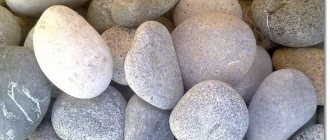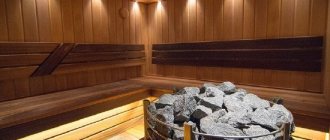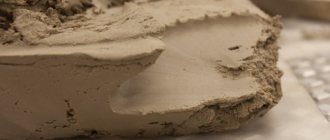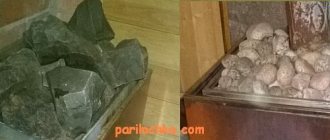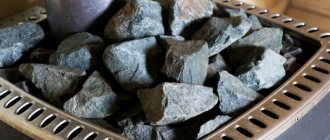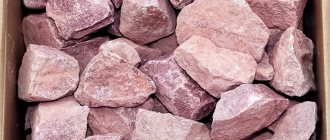Photo from Wikipedia, by Immanuel Giel
Today, there are only two bath stones that can rightfully be called “the steamer’s dream” - this is jadeite , which we have already written about, and jade . The latter is better known as a semi-precious stone - who does not know about the great love of the Chinese for it, where the best for the best is made from this stone (or was made while the emperors ruled the Celestial Empire).
And the news that he is good at using a heater began to spread not so long ago - ten years ago, few people knew about it (and could afford it). Today the situation is different - anyone can buy it if they have the money. But the information... just advertising. So our article will come in handy, because we stick to the facts and stand on the side of the consumer.
Characteristics
Jade is a bath stone that is not only of amazing beauty, but also speaks of the high wealth of the owner. The mineral is not afraid of open fire. The more it warms up, the longer it will give off heat. Even with strong heating and sudden cooling, cracks do not appear on it. On the contrary, it hardens the rock.
Chemical properties
Jade can be of two types. With iron impurities it is called actinolite. If there are practically no iron impurities in the composition, then it is called tremolite. The composition contains about 56% silica, so it belongs to alkaline rocks.
Color, structure, value
Jade can have different shades. The color depends on the predominant amount of impurities in a particular specimen:
- The pink stone contains magnesium impurities;
- if the mineral is brown or pale green, then it contains iron impurities. An excess of iron turns the stone black;
- bright and rich green color symbolizes the presence of chromium;
- There are no impurities in white rocks. It is extremely rare to find actinolite or tremolite in their pure form. Its structure will be transparent and uniform;
- Sometimes specimens are found with stripes or veins that have formed chromite or hematite.
The semi-precious jade stone is also used to decorate jewelry. Its cost may vary, since not all samples are suitable for jewelry making. However, for those who choose jade for a bath, this information is not so important. For kindling the heater, do not choose a gem-quality rock. In nature you can find a lot of jade, suitable for the production of finishing tiles or kindling for a bath.
Mineral composition and origin
Jade is a fine-crystalline rock, which was formed by many amphibole crystals, arranged chaotically. The naked eye cannot notice these crystals. The stone is almost impossible to split due to the miniature nature of these crystals.
When a mass of dolomite or serpentine is flooded with molten magma, jade is formed. Potassium, silica and water contribute to the formation of mica during treatment; a zone of amphiboles is formed on the icy coil, followed by talc rocks. Jade formation occurs close to the surface.
Physical and mechanical properties
The rock has a fibrous structure, which increases strength and toughness. The suitability of jade for use in a sauna or bath is determined by its hardness and density. Standard hardness is 5.5-6.0. However, there are samples containing talc and serpentinite, their hardness is below 5.5. The density of the stone is 2.8-3.4 g/cm3.
The following characteristics of the mineral are also important:
- Thermal conductivity coefficient (W/m*K) 1.6-2.9
- Specific heat capacity (kJ/kg*K) 1.0-1.2
- Thermal diffusivity coefficient (m²/s) 5.3-8.1.
How to choose the right jade and avoid being scammed
Jade stones for baths
It was not for nothing that we paid so much attention to the formation of jade above. serpentinite (coil) instead of it (or together with it) This is no coincidence, because in most cases they coexist in nature. However, the coil is not suitable for a bathhouse - there it quickly becomes unusable.
IMPORTANT! It is not difficult to distinguish jade from a coil: it is extremely difficult, almost impossible, to split jade, but a coil can be easily and easily split with a hammer . You can also use a knife - serpentine is soft (3.5 Mohs) and is easily scratched with a knife , which cannot be said about jade.
It goes without saying that any chipped stones passed off as jade will be fake.
If jade is combined with talc rocks or serpentinite, its quality is much worse than in its pure form. It's better not to take this one. And the same knife or steel needle will help you decide - the blade of the knife or the tip of the needle has a hardness of up to 5.5 Mohs. The hardness of jade starts at 5.5.
Unfortunately, there are many similarities between jade and chalcedony . Chalcedony is fibrous quartz. You can distinguish them by hardness (chalcedony has a hardness of 7, jade has a hardness of 5.5-6). A thin file made of good steel with a hardness of 6.5 will do - it will leave a scratch on jade, but not on chalcedony .
IMPORTANT! In addition, chalcedony can be split - the fracture occurs parallel to the fibers, resulting in a rough surface.
Useful video
We recommend watching the following video, which demonstrates ways to distinguish between real jade and counterfeits:
Beneficial features
Jade is perfect for a bath, as it has the following advantages:
- durability, wear resistance;
- high strength and hardness;
- good, long-lasting heat dissipation with rapid heating;
- attractive appearance, variety of shades;
- formation of soft steam.
Jade steam is rich in healing properties; it has the following benefits for the human body:
- Cleansing, skin rejuvenation.
- Normalization of metabolism, cleansing the body of toxins.
- Calming effect on the nervous system.
- Elimination of insomnia, increased anxiety.
- Relieving fatigue and improving sleep.
- Stabilization of blood pressure.
- Eliminate headaches.
- Curing kidney diseases.
- Improved heart function.
- Healing effect and elimination of colds.
How to choose the right jade and avoid being scammed
To avoid becoming a victim of scammers when purchasing jade, you need to know the main characteristics of this stone, its differences from other cheaper and low-quality rocks. Instead of jade, they can often sell plastic, glass or coils, which in appearance are very similar to the semi-precious mineral. You need to check for the following signs of nephritis:
- High strength. It will not be possible to split it with a hammer, which cannot be said about a fake. You can also touch one copy at a time with something sharp (a needle, a knife). There will be a scratch on the fakes, but not on the jade.
- Jade rock is one of the most expensive materials for a bathhouse. Therefore, when you see a price tag that is too low, profitable promotions, or sales, you should be wary and not happy.
- The shape of the mineral is most often round; square specimens are less common.
- No other breeds should be included in the structure. If there are a lot of such impurities, the stone will quickly crack during use.
We reject fakes: what you need to know when choosing jade
The high price of the stone pushes unscrupulous businessmen to various kinds of tricks and falsifications, when they try to sell an inexperienced but wealthy client anything but jade.
The most visually similar to jade are serpentine and chalcedony, which is a fibrous variety of quartz. The coil itself is quite good, but exposure to high temperature and water leads to the leaching of calcium crystals from it, which leads to the banal short-term destruction of the stone and its transformation into amorphous stone fines and screenings, which are simply not able to perform their functions in the heater. Chalcedony, being a much cheaper and more widespread mineral, has slightly different physical characteristics, which makes its vapor flatter, harder and, in general, very ordinary. Therefore, here are the basic techniques for identifying counterfeits:
- The coil has a Mohs hardness in the region of 3.4-3.6 units. Its surface can be easily scratched with the edge of a knife. Jade, when used with a standard heat-treated steel knife, will not be scratched. In addition, due to its structure, the coil easily splits when hit with a hammer. Jade, on the contrary, is viscous and plastic and it will not be possible to split it with blows of similar force;
A word from Experienced! For the sake of objectivity, it should be said that jade, with admixtures of sedimentary talc rocks, has a reduced hardness, about 5.5 Mohs units. Its durability and steam quality are significantly inferior to classic pure jade. Such a stone can be identified using a steel sewing needle. A light blow with a hammer on a needle placed on a stone leaves a depression on the substandard material, which is clearly visible when illuminated in oblique light.
- A hardness test will also help identify chalcedony, this time for increased hardness; for quartz it is about 7 Mohs units. We take a high-quality needle file made of carbon tool steel of type U8, U10, U10A and scratch the control mineral with it. The jade will have visible serifs; the chalcedony will remain intact.
How to care for stones
All jade care is very simple and comes down to simply washing the stones. But you cannot use chemicals or abrasives for this. After purchasing new minerals, they must be thoroughly washed. The mineral should lie in water with salt for 3-4 hours, then it is rinsed in clean water, you can rub it with a soft brush and wipe it, let it dry thoroughly, and only then put it in the oven. The procedure should be carried out from 1 to 4 times a year, depending on the frequency and intensity of use of the steam room.
How to use
The method of use depends on the form in which the person acquired the jade:
- fine scattering - for massage and spot application with heated stones, decoration on shelves, in bowls, vases, detailed finishing of stoves and furniture;
- large scattering - in heaters and for decoration;
- bricks, tiles, blocks - for laying out entire walls, inserting them, finishing the stove, flooring, making furniture for procedures and relaxing in the steam room.
In all cases, the mineral can and should be periodically moistened with water in order to generate a new portion of steam.
With the help of the warmth of jade, blood circulation increases and improves... The jade massage table is used for spa treatments: wraps, peelings, thalassotherapy, mud therapy, soap massage.
Disadvantages of Jade
The main disadvantage of the rock is the high cost of jade compared to other bath stones. Another drawback is the existence of a huge number of fakes on the market of bath stones. Therefore, you need to buy it only in specialized stores. You also need to take into account this fact that the jade bath has some contraindications. People with chronic diseases in the acute stage, heart problems, liver diseases, kidney diseases, the presence of malignant tumors, tuberculosis, purulent inflammations of the skin should not visit her.
Rules for choosing a quality mineral
When choosing stones for a bath, you should first study the information about what they should be. During the selection process, it is recommended to adhere to the following recommendations:
- the shape must be round and the surface smooth - all this contributes to good air circulation and heating;
- if the heater is small in size, then the selected rocks should be small;
- there should be no inclusions of other types of rock, mica and defects that will lead to rapid destruction;
- Before you start using stones, you need to first check them for cracks and chips.
As a test, it is recommended to heat the stone and place it in ice water - the rock should not split after this.
Advice! The ideal option is to select boulders whose size varies from 5 to 20 cm.
By what criteria can you choose a good stone?
The stones in the sauna stove must warm up quickly, retain heat for as long as possible, and also not break or be damaged by extreme temperature changes for several years. That’s why you should select them based not only on their appearance, but also on their properties.
Heat capacity
The ability of a stone to retain heat is perhaps the most important characteristic that you should rely on when choosing. That is why it is best if the heat capacity of the stones for the bathhouse stove approaches one or even exceeds this value.
Heat resistance
During bathing procedures, the stones are first strongly heated, and then water is poured onto them to create steam. Not every rock can withstand such sudden temperature changes. For example, the heat resistance indicator is considered quite high for jade, cast iron, chromite and some other stones, and less high, but still acceptable, for jasper, quartz, etc. The choice also depends on the type of stove: if it is closed, the bath stones in it are exposed to open fire, so the heat resistance parameter in this case is especially important. It is no coincidence that jade, porcelain and cast iron are often recommended for such stoves.
Size and shape
The optimal size of the stones is directly proportional to the dimensions of the furnace. It also depends on the type of heater. Large specimens (from 7 cm) are preferable for wood-burning stoves, while it is better to place smaller ones in electric ones. Also, large stones are traditionally used in closed-type heaters, since they better withstand strong heat. Many novice sauna lovers are concerned about the question of whether it is better to choose polished or chipped stones. To answer this, you need to decide what is more important: the durability of the stone or its more efficient heat transfer. The fact is that chipped specimens emit steam more strongly, but their wear resistance is lower than that of smooth ones.
Safety
Which bath stone is best to use so that water treatments don’t go wrong? This is another very important question. Before going on sale, stones must undergo radiation control. In addition, it is important that they do not contain hazardous impurities. If you are offered to buy stones at a price significantly lower than the market price, this is a reason to carefully check their origin. Goods from unreliable suppliers may be collected at railroads or other places where they have accumulated substances harmful to the human body over a long period of time.
Mine or buy?
Good minerals for a sauna heater are far from cheap. Therefore, sometimes people engage in “gathering.” For example, sea or river pebbles are stones that can be found in abundance along the banks of reservoirs. Pebbles collected from fresh lakes or along the banks of rivers are more durable and heat-resistant than sea pebbles.
Collecting rocks yourself requires skill and knowledge about minerals. Otherwise, this is not just a thankless, but also an unsafe task. In particular, if you collect pebbles from a railway embankment, you risk paying for your own health. Treated with chemicals, stones emit a harmful odor when heated. And the fumes from them are completely dangerous. Not to mention the fact that the purpose of a railway embankment is somewhat different than the supply of stones for a private bathhouse.
Another advantage of buying in a specialized store is the opportunity to purchase minerals of the desired type, and not just something that came to hand by chance. The set of stones “from the store” is balanced not only in chemical composition, but also in size. The samples are treated with special environmentally friendly compounds that destroy harmful microorganisms.
Rules for using the heater
When using the heater, special attention must be paid to safety rules. Thus, if there are stones with dirt or carbon deposits in the heater, they must be removed, washed thoroughly, allowed to dry and placed back in the oven. If the bathhouse is used quite often, then every 3 months it is worth carefully inspecting the breed for defects and damage.
To obtain steam, the rock must be watered with hot water without adding essential oils. As a rule, all additives are poured into a separate heat-resistant container, mixed with water and placed on the stones. This approach minimizes the amount of carbon deposits and increases the service life.
Sources
- https://zen.yandex.ru/media/id/603ce50c28e3d117d95e26be/kakie-kamni-dlia-bani-luchshe-vybrat-6052fcb4a779365202c9abd8
- https://gadgetok.ru/top-luchshih-kamnej-dlya-bani.html
- https://kachestvolife.club/stroitelstvo/banya/nefrit-svoystva-primenenie-dlya-bani-i-sauny
- https://asgard-cmk.ru/raznoe/zhadeit-ili-nefrit-chto-luchshe-dlya-bani.html
- https://zpu-tmb.ru/stroitelstvo-i-otdelka/nefrit-dlya-bani-otzyvy-nedostatki.html
- https://obane.info/atributy/nefrit-dlja-bani.html
- https://2proraba.com/banya/kakie-kamni-dlya-bani-luchshe-vybrat.html
Purpose of stones
In baths and saunas, stones are necessary to accumulate and retain heat and create steam. With its help, a rise in temperature is achieved that can be maintained at the same level.
If desired, the steam can be made dry or wet. In the first case, the air will warm up to 120 °C. High temperature is a distinctive feature of dry steam. Low humidity makes it easier to withstand heating. In this case, a harsh effect on the body occurs, however, the therapeutic effect of visiting saunas with dry steam is more effective.
Wet steam, characteristic of a Russian bath, is generated by pouring boiling water over the stones. In modern buildings, closed heaters with water supply are used for this.
When heated, moist air acts like inhalation, but you cannot stay in a steam room at a temperature of 100 °C for a long time. This is especially true for people with cardiovascular pathologies. The air temperature is easily regulated and in most cases is maintained within 60 – 80 °C.
Expert opinion
Sumskikh Stas Viktorovich
Bath attendant with 10 years of experience
When choosing stones, you should pay attention to their size and heat capacity, which determines the intensity of heat transfer.
